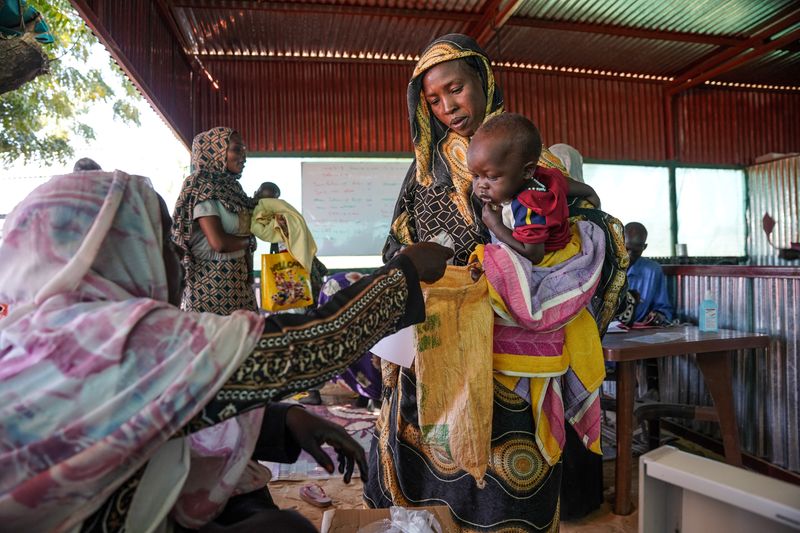ZAMZAM CAMP, Sudan (Reuters) -A famine-stricken camp in Sudan’s conflict-torn Darfur area is going through a major new inflow of displaced folks whereas floods threaten to infect water and sanitation services, in keeping with satellite tv for pc imagery revealed on Friday.
The findings from Yale Humanitarian Analysis Lab present that bogs and 9 out of 13 water factors have been inundated on the Zamzam camp for internally displaced folks (IDPs) in North Darfur, elevating the danger of cholera and different illnesses in an space already going through excessive ranges of malnutrition.
The camp, internet hosting about 500,000 folks, has turn into extra crowded as folks have fled latest combating between Sudan’s military and the paramilitary Speedy Assist Forces (RSF), which broke out in April 2023.
The photographs analysed by the Yale researchers present brown floodwaters submerging outside bogs and areas the place folks queue for water.
“We need water, food, healthcare, and for God to lift this curse from Sudan, nothing more than that,” stated Duria Abdelrahman, who advised Reuters she had obtained no help since arriving within the camp. Girls have been seen cleansing leaves to eat.
Zamzam is the most important IDP camp in Sudan, and a few folks have lived there for greater than 20 years.
On Thursday, the world’s international starvation monitor decided that Zamzam is experiencing famine, solely the third such evaluation because the Built-in Meals Safety Part Classification, a world meals safety commonplace, was established 20 years in the past.
In its first response to the famine classification, the RSF on Friday declared “full solidarity” with victims of the famine and repeated a suggestion to work with the United Nations to facilitate supply of help.
Assist staff say the military has obstructed humanitarian entry in the course of the warfare whereas the RSF has looted giant portions of help that has acquired by way of.
Each side deny impeding aid efforts.
“For humanitarians, our worst-case scenario, what we train for as the sum of all fears, is happening on the ground right now,” stated Nathaniel Raymond, government director of the Yale Humanitarian Analysis Lab.
“A population already vulnerable due to being food and water deprived, on the move and under siege, now is surrounded by floodwaters that are contaminated with human and animal faeces.”
Zamzam is close to al-Fashir, capital of North Darfur and the one vital holdout from the RSF throughout Darfur. A minimum of 65 folks have been killed this week because the group besieges town.
The primary hospital is out of service after an RSF assault.
DIRTY WATER
Zamzam and different areas the place greater than 300,000 folks have fled are managed by armed teams which are impartial or allied with the federal government and due to this fact provide some safety. However they’ve little meals and few companies as a result of the military and RSF have prevented help from getting into.
Residents say they can not attain farms as RSF troopers encompass the world, whereas most don’t have any cash for the little meals that enters markets. The IPC stated the Abu Shouk and al-Salam camps in al-Fashir are possible going through related situations to Zamzam.
Residents have restricted entry to contemporary water, the Yale researchers stated.
“The water is unsafe because it mixes with all the dirt,” Zamzam resident Yahia Ali advised Reuters, pointing to brown rainwater collected in a tarp. “And even though it’s dirty we are forced to drink it.”
The Yale researchers used satellite tv for pc imagery to establish sufficient standing water on the camp to cowl at the least 125 soccer pitches. The researchers additionally documented submerged bogs at Al Salam College 36 for Adolescents and one other college compound.
A Reuters eyewitness stated newcomers from al-Fashir sheltering in a roofless college had water as much as their knees.
In al-Fashir, the Yale researchers documented flooding of hospitals, meals and water distribution websites, and markets. The Mawashi Market, the place livestock is slaughtered and bought, was additionally inundated and the researchers referred to as it “a particularly concerning vehicle of contamination”.
As of early July, Sudan had 11,000 cholera instances nationwide, in keeping with the well being ministry, though none had been recorded in North Darfur.
Waterborne illness outbreaks occurred in Darfur throughout a devastating battle that started in 2003.

Zamzam is considered one of 14 places throughout Sudan the place the IPC has stated famine is probably going, most of them different displacement camps which have seen little help enter because the newest warfare started.
“This is not just the situation in Zamzam, but the condition of all the other camps in Darfur, more than 171 camps suffering the same conditions,” stated Adam Rojal, spokesman for the Displacement Camps Coordinating Committee, an activist community.




